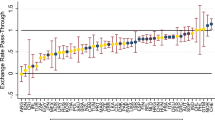Abstract
This study assesses the response of the trade balance to exchange rate fluctuations across a large number of countries. Fixed-effects regressions are estimated for three country groups (industrial, developing and emerging markets) on annual data for 87 countries from 1994 to 2010. The trade balance improves significantly after a real depreciation, and to a similar degree, in the long run for all countries, but the adjustment is significantly slower for industrial countries. Emerging markets and developing countries display relatively fast adjustment. Disaggregation into exports and imports shows that the delayed adjustment in industrial countries is almost entirely on the export side. The rate of adjustment in emerging markets is slowing over time, consistent with their eventual graduation to high-income status. The ratio of trade to GDP is also highly sensitive to the real effective exchange rate, with a real depreciation of 10 % raising the trade/GDP ratio across the sample by approximately 4 %. This result, which presumably reflects movements in the prices of tradables relative to non-tradables, raises questions about the widespread use of the trade/GDP ratio as a trade policy indicator, without adjustment for real exchange rate effects.
Similar content being viewed by others
Notes
The choice of 1994 as the start date is somewhat arbitrary. For a reduced sample of countries, data from before 1994 could be used, extending the time dimension, but at the risk of introducing more structural breaks if any have occurred. Note also that, because of time-lags in the regression, real exchange rate data back to 1992 are used.
For example they are equal to −0.088/0.518 = −0.170 for the whole sample. The similarity also suggests that extra lags of the real exchange rate are not required in Table 2.
The data are in US dollars, but the fixed country and time effects imply that the results would be the same for any currency.
References
Aguiar M, Gopinath G (2007) Emerging market business cycles: the cycle is the trend. J Polit Econ 115(1):69–102
Alessandria G, Kaboski JP, Midrigan V (2010) Inventories, lumpy trade and large devaluations. Am Econ Rev 100(5):2304–2339
Bahmani-Oskooee M, Hegerty SW (2010) The J- and S-curves: a survey of the recent literature. J Econ Stud 37(6):580–596
Bahmani-Oskooee M, Ratha A (2004) The J-curve: a literature review. Appl Econ 36(13):1377–1398
Bayoumi T, Faruqee H (1998) A calibrated model of the underlying current account. In Isard P, Faruqee H (eds) Exchange rate assessment: extensions of the macroeconomic balance approach, Occasional Paper no. 167. International Monetary Fund, Washington DC
Bleaney M, Francisco M (2010) What makes currencies volatile? An empirical investigation. Open Econ Rev 21(5):731–750
Boyd D, Caporale GM, Smith R (2001) Real exchange rate effects on the balance of trade: cointegration and the Marshall-Lerner condition. Int J Finance Econ 6(3):187–200
Calvo GA, Izquierdo A, Loo-Kung R (2006) Relative price volatility under sudden stops: the relevance of balance sheet effects. J Int Econ 69(1):231–254
Campa JM, Goldberg LS (2005) Exchange rate pass-through into import prices. Rev Econ Stat 87(4):679–690
Christopoulos DK, Gente K, Léon-Ledesma MA (2012) Net foreign assets, productivity and real exchange rates in constrained economies. Eur Econ Rev 56:295–316
Crucini MJ, Davis JS (2013) Distribution capital and the short- and long-run import demand elasticity. NBER Working Paper no. 18753
Drozd LA, Nosal JB (2012) Understanding international prices: customers as capital. Am Econ Rev 102:364–395
Durdu CB, Mendoza EG, Terrones ME (2013) On the solvency of nations: cross-country evidence on the dynamics of external adjustment. J Intern Money Finance 32:762–780
Engel C, Wang J (2011) International trade in durable goods: understanding volatility, cyclicality, and elasticities. J Int Econ 83(1):37–52
Frankel JA (2005) Contractionary currency crashes in developing countries. NBER Working Paper No. 11508
Frankel JA (2010) Monetary policy in emerging markets: a survey. NBER Working Paper No. 16125
Gallaway MP, McDaniel CA, Rivera SA (2003) Short-run and long-run industry-level estimates of U.S. Armington elasticities. N Am J Econ Finance 14(1):49–68
Goldstein M, Khan MS (1985) Income and price effects in foreign trade. In Jones RW, Kenen PB (eds) Handbook of international economics, 1041–1105
Harberger AC (1957) Currency depreciation, income, and the balance of trade. J Polit Econ 58(1):47–60
Hooper P, Johnson K, Marquez J (1998) Trade elasticities for the G-7 countries. Federal Reserve Board of Governors International Finance Discussion Paper no. 609
Imbs J, Mejean I (2009) Elasticity optimism. IMF Working Paper no. 09/279
Isard P (2007) Equilibrium exchange rates: assessment methodologies. IMF Working Paper no. 07/296
Krugman PR, Baldwin RE, Bosworth B, Hooper P (1987) The persistence of the U.S. trade deficit [with comments]. Brookings Papers on Economic Activity: 1–55
Lane PR, Milesi-Ferretti GM (2004) The transfer problem revisited: net foreign assets and real exchange rates. Rev Econ Stat 86(4):841–857
Matsuyama K (1992) Agricultural productivity, comparative advantage, and economic growth. J Econ Theory 58(2):317–334
Rose AK, Yellen JL (1989) Is there a J-curve? J Monet Econ 24(1):53–68
Sachs JD, Warner AM (2001) The curse of natural resources. Eur Econ Rev 45(4–6):827–838
Acknowledgements
The authors wish to thank John Gathergood, George Tavlas and an anonymous referee for helpful comments on an earlier draft.
Author information
Authors and Affiliations
Corresponding author
Appendices
Appendices
1.1 Appendix 1
1.2 Appendix 2
1.3 Appendix 3
Rights and permissions
About this article
Cite this article
Bleaney, M., Tian, M. Exchange Rates and Trade Balance Adjustment: A Multi-Country Empirical Analysis. Open Econ Rev 25, 655–675 (2014). https://doi.org/10.1007/s11079-014-9310-3
Published:
Issue Date:
DOI: https://doi.org/10.1007/s11079-014-9310-3



